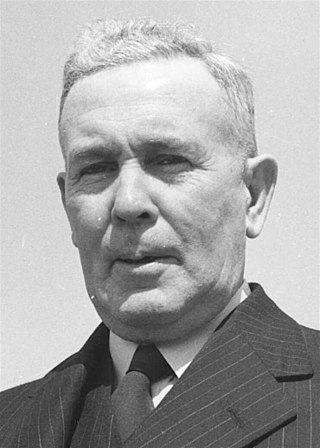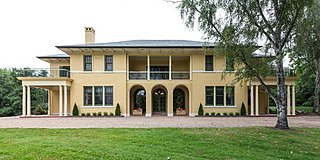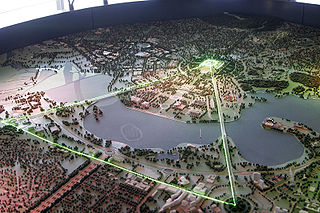
The prime minister of Australia is the head of government of the Commonwealth of Australia. The prime minister is the chair of the Cabinet of Australia and thus the head of the federal executive government. Under the principles of responsible government, the prime minister is both responsible to and a member of the Commonwealth Parliament. The current prime minister is Anthony Albanese of the Australian Labor Party, who assumed the office on 23 May 2022.

Joseph Benedict Chifley was an Australian politician and train driver who served as the 16th prime minister of Australia from 1945 to 1949. He held office as the leader of the Australian Labor Party (ALP), having previously served as the treasurer of Australia under Prime Minister John Curtin and later himself from 1941 to 1949. He was notable for defining Australia's post-war reconstruction efforts.

The Lodge is the primary official residence of the prime minister of Australia. Located at 5 Adelaide Avenue in the Canberra suburb of Deakin, it is situated a short distance away from Parliament House. The Lodge is one of two official prime ministerial residences, the secondary official residence being Kirribilli House in Sydney. The building was completed in 1927 in the Georgian revival style, since then twenty-three people have served as prime minister, six of whom chose to live elsewhere either full- or part-time during their tenure, and two who chose to live at Kirribilli House.

Civic is the city centre or central business district of Canberra. "Civic" is a common name for the district, but it is also called Civic Centre, City Centre, Canberra City and Canberra, and its official division name is City.

Yarralumla is a large inner south suburb of Canberra, the capital city of Australia. Located approximately 3.5 km (2.2 mi) south-west of the city, Yarralumla extends along the south-west bank of Lake Burley Griffin from Scrivener Dam to Commonwealth Avenue.

Reid is a suburb of Canberra, Australian Capital Territory, Australia. With a population of 1,544 at the 2021 census, located directly next to Civic, Reid is one of the oldest suburbs in Canberra. It is named after George Reid, the fourth prime minister of Australia.

Braddon is an inner north suburb of Canberra, Australian Capital Territory, Australia located adjacent to the Canberra CBD.

Barton is a suburb of Canberra, Australian Capital Territory, Australia. At the 2021 census, Barton had a population of 1,946 people.
South Canberra, or the Inner South, is a subdivision of Canberra Central in the Australian Capital Territory in Australia.

The Hotel Canberra, also known as Hyatt Hotel Canberra, is a historic hotel in the Australian national capital, Canberra. It is located in the suburb of Yarralumla, near Lake Burley Griffin and Parliament House. It was built to house politicians when the Federal Parliament moved to Canberra from Melbourne in 1927. It was constructed by the contractor John Howie between 1922-1925. Originally opened in 1924 as Hostel No. 1, in 1927 it became known as the Hotel Canberra.

Government-owned housing in Canberra and the Australian Capital Territory has a history stemming from the decision to build the National Capital in the bush. In the early years Canberra's housing was entirely government-built and even after private development took over there has been a number of government houses included in almost every new suburb. Typical Canberra public housing is built on a limited number of plans repeated through an area of a suburb, with two or three bedrooms and constructed in unfinished brick veneer. They typically range in size from around 80 m2 to 130 m2. The term Govie is a colloquialism used to describe the typical Canberran government built house.

Old Parliament House, formerly known as the Provisional Parliament House, was the seat of the Parliament of Australia from 1927 to 1988. The building began operation on 9 May 1927 after Parliament's relocation from Melbourne to the new capital, Canberra. In 1988, the Commonwealth Parliament transferred to the new Parliament House on Capital Hill. Since 2009, Old Parliament House has become a museum about the building and Australian democracy more broadly, named the Museum of Australian Democracy at Old Parliament House (MoAD). It also serves as a venue for temporary exhibitions, lectures and concerts.

The National Triangle, which is referred to as the Parliamentary Triangle, is the ceremonial precinct of Canberra, containing some of Australia's most significant buildings. The National Triangle is formed by Commonwealth, Kings and Constitution Avenues. Buildings within the National Triangle have been located and designed intentionally for visual effect, and those of national significance are popular tourist attractions.

Ainslie is a suburb of Canberra, Australia in the North Canberra district.

John Smith Murdoch was a Scottish architect who practised in Australia from the 1880s until 1930. Employed by the newly formed Commonwealth Public Works Department in 1904, he rose to become chief architect, from 1919 to 1929, and was responsible for designing many government buildings, most notably the Provisional Parliament House in Canberra, the home of the Parliament of Australia from 1927 to 1988.

The Edmund Barton Building is a large Canberra office building positioned prominently on the Parliamentary Triangle in the suburb of Barton, Australian Capital Territory. It was designed by the Australian architect Harry Seidler. It is named after Sir Edmund Barton, first Prime Minister of Australia and one of the founding judges of the High Court of Australia.

Elizabeth Gibson Chifley was the wife of Ben Chifley, the Prime Minister of Australia from 1945 to 1949.

Mercure Hotel Canberra, historically known as the Hotel Ainslie and Olims is a historic, four star hotel located in the inner Canberra suburb of Braddon, Australian Capital Territory. It is the closest major hotel to the Australian War Memorial and is located on Limestone Avenue. The Hotel Ainslie has been listed on the Australian Institute of Architects' Register of Significant Twentieth Century Architecture since 1984 due to its significance as a rare late example of English Arts and Crafts architecture and was previously listed in the now defunct Register of the National Estate. It is listed on the ACT Heritage Register.

Gorman House in Braddon, Australian Capital Territory is an Art Deco landmark house located in inner Canberra. It operated as a hostel from 1924 until 1972 and has subsequently become a popular centre for theatre and the creative arts in fields such as photography, dance, acting and music. It is listed on the National Heritage Register which describes it as "a fine and externally intact example of John Smith Murdoch's garden pavilion style, which makes a creditable contribution to the townscape." The garden pavilion style is characterized by low buildings, covered paths and open courtyards.



















